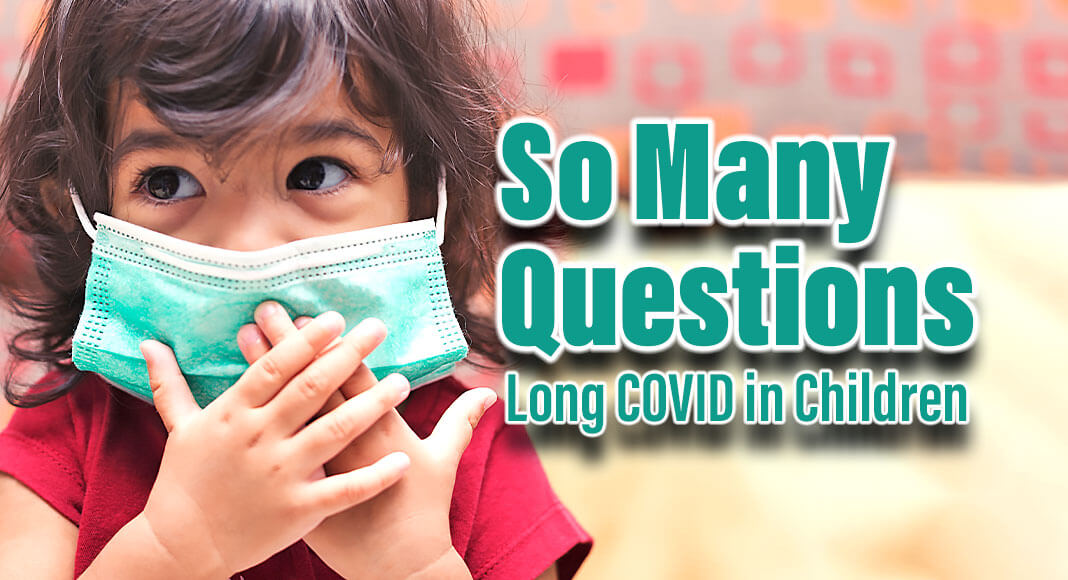
Mega Doctor News
By Michael Merschel, American Heart Association News
In the constantly unfolding tale of the pandemic, long COVID – the persistent effects that can follow a SARS-CoV-2 infection – is among the more challenging twists, one that researchers are just beginning to grasp in adults.
And in children, it might be a whole other story.
“It’s a very difficult collection of symptoms, without a clear single treatment,” said Dr. Sarah de Ferranti, a pediatric cardiologist at Boston Children’s Hospital. “I think it’s particularly difficult for parents to help their children with this, because it’s hard to figure out what symptoms are related to COVID versus other illnesses, and because long COVID in kids is different from long COVID in adults.”
Questions abound about long COVID’s causes and how common it is, and parents need to be aware of both physical and psychological aspects. But clearly, it’s “a real entity,” said Dr. Suchitra Rao, an infectious disease specialist at Children’s Hospital Colorado in Aurora, and something that children “can be quite debilitated from.”
Long COVID goes by several names. Researchers may refer to it as post-acute sequelae of SARS-CoV-2, or PASC. The Centers for Disease Control and Prevention uses “post-COVID conditions” for the wide range of health consequences that can be present four or more weeks after infection. A World Health Organization definition adopted in February says “post COVID-19 condition” in children involves symptoms that began within three months of COVID-19 and last at least two months.
According to the CDC, children seem to be affected by post-COVID conditions less frequently than adults, but estimates vary widely on how common the problem is.
How many children are affected by long COVID?
“I would say on average, we’re looking at somewhere between 4% to 25% of kids who have had a SARS-CoV-2 infection go on to have symptoms of long COVID,” said Rao, who also is an associate professor at the University of Colorado School of Medicine. However, “it’s a very difficult question to answer, just because different groups are exploring this in slightly different ways, with different definitions.”
Rao led a study published last August in JAMA Pediatrics that used data from 659,286 children across the U.S. Comparing those who tested positive for COVID-19 with those who did not, the study put the rate of long COVID at slightly less than 4%.
De Ferranti, who also is an associate professor of pediatrics at Harvard Medical School, said that’s probably a reasonable number. Some studies might have overestimated prevalence because many children develop long COVID without having had visible COVID-19 symptoms, she said.
A wide range of symptoms
Similarly, long COVID experiences vary from child to child, de Ferranti said. “Some might have more cardiac concerns, and others are more neurologic or gastrointestinal.”
The American Academy of Pediatrics says long COVID can include up to 60 symptoms. And the list might not be the same for children and adults, Rao said.
Both groups experience headaches, fatigue, “brain fog,” concentration difficulties and loss of taste and smell, she said. “But we’re also seeing some additional unique features in kids.”
In her team’s work, skin rashes, diarrhea, abdominal pain and vomiting “seem to be a little bit more common in children,” who also seem to recover more quickly than adults. Older children are more likely to develop postural orthostatic tachycardia syndrome, or POTS, which can cause heart palpitations and dizziness, she said.
A rare condition called multisystem inflammatory syndrome in children, or MIS-C, that affects multiple organs can follow COVID-19. Researchers would consider it a post-COVID condition, Rao said, although it’s also a distinct illness.
“I do think that’s a different animal,” de Ferranti said.
De Ferranti, who helped craft treatment guidance on pediatric long COVID and co-wrote a 2022 American Heart Association scientific statement on cardiac effects of the coronavirus in children and young adults, said that a good number of patients with long COVID do not have prior problems that would seem to make them vulnerable.
“These are generally healthy kids who get a virus and then are experiencing lots of fatigue, exercise intolerance or neurologic symptoms,” she said.
Cardiac concerns
De Ferranti said her patients have the same symptoms, such as chest pain or shortness of breath, that would have led parents to seek a cardiologist before the COVID-19 era. Some are worried about myocarditis, a rare heart inflammation that can follow a COVID-19 infection. (It can also follow vaccination, but research has consistently shown the risk is higher from infection.)
Such issues can be serious, de Ferranti said, but there is not always a clear connection with COVID-19. “While kids may certainly have cardiac symptoms like palpitations, I’m not seeing an onslaught of new, significant, scary coronary artery problems or arrhythmias or myocardial problems related to COVID.”
Deconditioning, or weakness from having been away from activity, may be a factor for some of the young people she sees, she said. “Certainly when we ease folks back into activity in an organized way, they seem to get better. But I don’t think that’s the only factor. I don’t think they’re presenting as unwell because they just haven’t been doing enough. There’s something going on here that we haven’t fully described yet.”
Mental health after COVID-19
Post-COVID mental health issues are “very common,” the AAP says. And again, many factors may be at play.
“There has certainly been an association between patients getting COVID and then going on to having issues with mental health, including anxiety and depression,” Rao said. But it can be hard to tease out the cause, “because it’s all happening in the context of what took place during the pandemic,” including school closures and social isolation.
Anxiety, she said, appears differently in children than in adults. “A lot of kids that were being seen in long COVID clinics would be complaining of chest pain, but sort of higher up in their chests – almost like a throat pain, low neck, upper chest kind of pain or tightness. And that could be manifestation of anxiety.” Some had vocal cord problems, which also can be related to anxiety.
Physical and mental issues can interact, which is why de Ferranti said treatment for post-COVID conditions should include an assessment for mental health symptoms.
She and Rao agreed that the first professional a parent should consult is their child’s pediatrician.
“This is something that can present very broadly, and it’s something that we’re learning more about,” Rao said. Starting with a primary care doctor is “always a good idea to figure out next steps to rule out other things that may not be related to long COVID.”
A family pediatrician also can help navigate the series of specialists who can look at specific issues and make sure everyone is on the same page, de Ferranti said.
Many large health care centers have pediatric long COVID clinics. De Ferranti said the RECOVER research project, supported by the National Institutes of Health, can steer families toward clinical trials studying long COVID.
For prevention, both doctors agreed on the power of vaccines. “Vaccinations are very effective in preventing COVID infections and severe COVID infections,” Rao said. “So that means that directly, they will also reduce the risk of having long COVID.”
For those already grappling with the illness, de Ferranti advises persistence and patience as researchers look for answers.
“Right now, we’re still kind of new in the game,” she said. “We’re still learning.”











